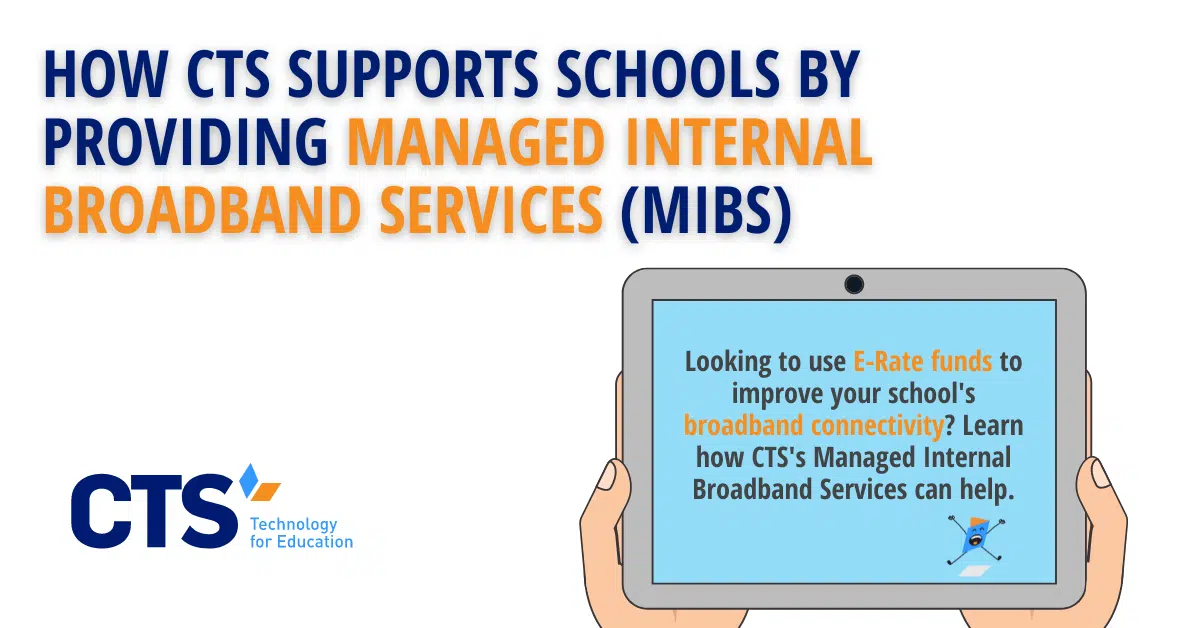School administrators can keep their internet reliable while protecting their time by partnering with a third-party vendor for Managed Internal Broadband Services (MIBS) and Basic Maintenance of Internal Connections (BMIC).
Reliable, high-speed internet access is an essential element of schooling today. Almost all aspects of daily school life are impacted by the availability of internet technology. Additionally, many of the efficiencies and innovations that came about during pandemic-related remote learning have been woven into the fabric of in-person instruction. From the streaming of instructional videos to student participation in personalized online programming, from online assessments to curricula stored in the cloud, from accessing Google Classroom to just simply accessing email or even just making a phone call with Voice over IP telephony, the internet is a crucial facilitator of learning and logistics in schools. Managed Internal Broadband Services can help a school or district keep their internet up and running.
Keeping this integral contributor to a school’s instruction and operations updated and functioning requires time and expertise. One of the most precious resources a school leader has is their time. An administrator’s attention is best suited for a focus on the quality of the curricula stored in the cloud, the effectiveness of the personalized online programming, and training and supporting teachers with the implementation of these online tools. Their focus shouldn’t be on the switches, routers, access points, or any other aspect of the internet infrastructure. Both the mechanics of the internet and the quality of learning that the internet enables are essential, but school leaders can outsource the former so that they can prioritize the latter. This is when partnering with a third-party IT vendor, that offers MIBS and BMIC, becomes a good option.
Through participation in the federal E-rate program, schools can access these services even with limited budgets.
The federal E-rate program, overseen by the Federal Communications Commission (FCC) and administered by the Universal Service Administrative Company (USAC), was established in 1996 with the goal of making telecommunications, internet access, and internal connections more affordable and accessible for schools and libraries across the country. Providing students with access to high-quality digital learning opportunities increases their engagement and achievement. Studies have shown that increased spending on internet access strongly correlates with improved academic performance. When the program began in the mid-90s, just 14% of K-12 American classrooms had access to the internet and by 2019, 99% of American classrooms had access to high-speed internet. The E-rate program has helped schools with smaller budgets still be able to provide their students with the benefits of reliable internet services. This level of access is a victory for American schools and for student learning.
New schools or schools that are expanding can make particularly good use of E-rate’s Category 2 funds, through MIBS, to invest in the costly equipment that forms the backbone of a school’s IT infrastructure. This might look like the procurement, installation, activation, and configuration of LAN/WLAN connection. With such high levels of internet access across the nation’s schools, a key ongoing focus – beyond procurement and installation – is maintenance and upgrades for existing networks and equipment. The good news is that E-rate funds can be used for these services as well. These are another set of Category 2 funds that can be used for the maintenance, repair, and upkeep of certain internal connections. This can also include technical support for bug fixes and security patches. All schools and school districts can benefit from these BMIC services.
E-rate’s list of eligible products and services for internal connections provides schools with critical funding for infrastructure building and maintenance.
Category 2 E-rate funds are designed to discount equipment and services related to the internal connections needed for broadband connectivity. The following are considered eligible products under a MIBS request: antennas, cabling, firewall components, racks, switches, Uninterruptible Power Supply, wireless access points, wireless control systems, and software that supports the components on the list.
Under a BMIC request, the following services are eligible: the repair and upkeep of hardware, maintenance for wires and cables, configuration changes, technical support services, bug fixes, security patches, and software upgrades.
Outsourcing management of these broadband components saves school leaders time.
For schools with limited IT staffing, managing the various components of broadband becomes one more task added to a long to-do list that may already include troubleshooting individual classroom technology issues like resetting a teacher’s password, helping a student access Google Classroom, or fixing a SmartBoard’s audio issues. As school leaders balance their priorities, even sourcing and procuring the additional routers, switches, and wireless access points can be a burden.
Partnering with an E-rate service provider to manage Wi-Fi and source the components can reduce the administrative burden and create the capacity for school leaders to focus more on their school’s mission.
Once a school decides to engage in the E-rate process, they will file a Form 470 and, in some cases, a request for proposal.
To apply for E-rate funding, all schools must submit Form 470, which describes the list of eligible services the school is requesting, to the USAC. Some schools, depending on local procurement rules, will need to submit a request for proposal document to initiate a bidding process. When reviewing bids, schools should assess who has the capacity to do this work in a manner that will save their time. What type of support does the provider offer? Is the troubleshooting remote-only or will they deploy a technician on-site upon request? Has this provider supported similar institutions? Do they understand the specific needs of your school and your mission? If not, a school may waste precious time trying to onboard these providers to their context.
At CTS, our Managed Internal Broadband Services and Basic Maintenance of Internal Connections offerings help our clients make the most of their E-rate funds
Every year up to $3.9 billion is available to eligible schools, districts, and libraries and, at CTS, we have strong expertise in supporting schools by maximizing this resource. By leveraging the E-rate program, school leaders have an opportunity to outsource the management of their internal broadband connections in a way that can take some of the pressure off an individual school or district. The availability of E-rate funds to discount the cost of these services also helps alleviate the financial pressure that may come with outsourcing.
Beginning with our bid submission, CTS takes the time to learn about the unique mission of each school client. We’ve worked with more than 60 schools across the United States to make the most of their E-rate funds. Our bids do more than meet the technology needs of our partners: they generate long-term relationships that help school leaders successfully execute their technology services visions. We have earned hundreds of E-rate awards with a total value of more than $10 million and we have the experience to know what it takes to meet your school’s education technology needs. Contact us today to learn more about how you can leverage your school’s E-rate funds to support the unique mission of your school.




